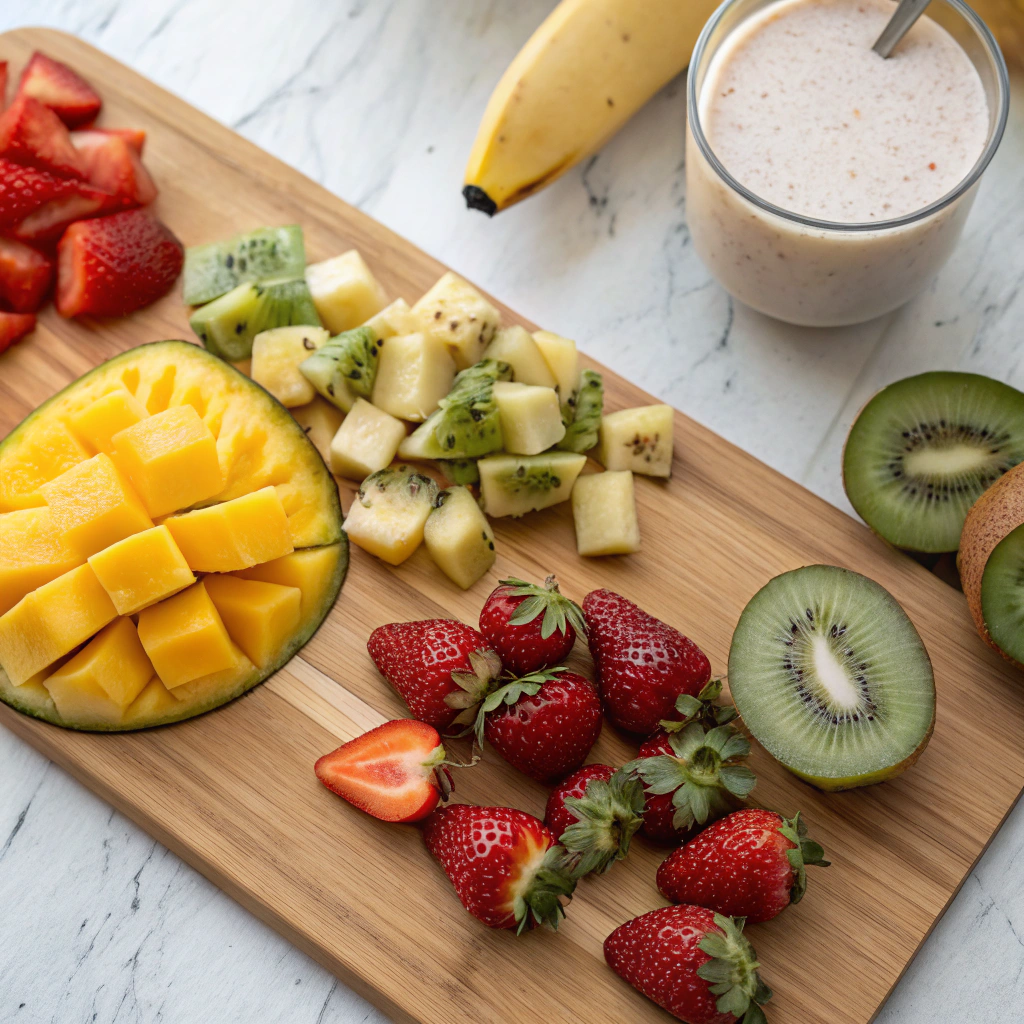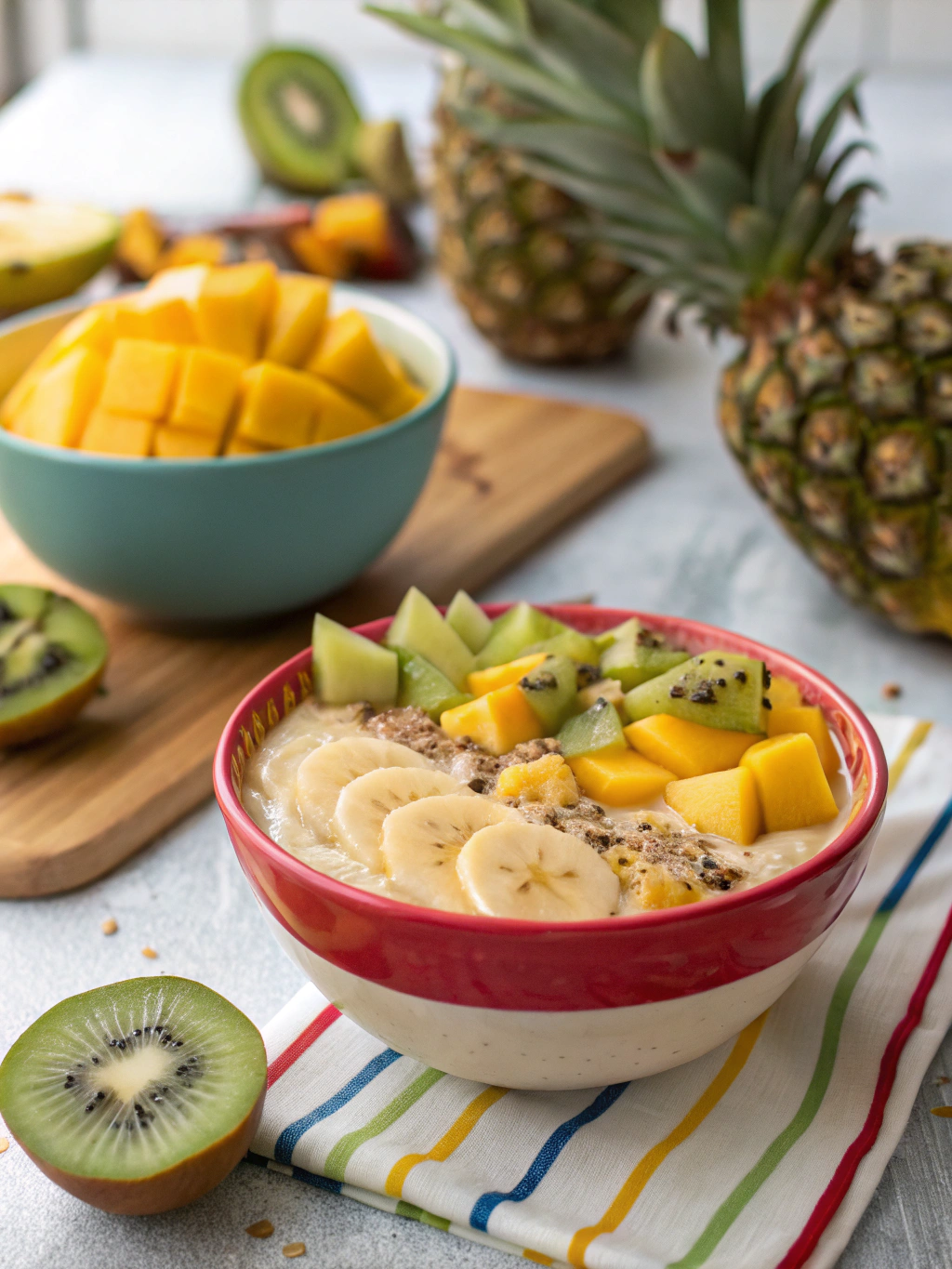Tropical Smoothie: 4 Simple Steps to Blend Like a Pro
Did you know that 68% of Americans struggle to consume their recommended daily fruit intake, while tropical smoothie enthusiasts are twice as likely to meet these nutritional goals? This refreshing, nutrient-packed beverage has transformed morning routines worldwide, combining the vibrant flavors of tropical fruits with incredible health benefits.
Perfect for busy mornings or post-workout refreshment, a well-crafted tropical smoothie delivers essential vitamins, minerals, and antioxidants in one delicious glass. Today, we’ll explore how to create the ultimate tropical smoothie that balances exotic flavors with nutritional excellence in just four simple steps.
Ingredients List

For the perfect tropical smoothie, gather these sun-kissed ingredients:
- 1 cup fresh pineapple chunks (juicy and sweet)
- 1 ripe mango, peeled and diced (look for slight give when gently squeezed)
- 1 ripe banana (yellow with light brown spots for optimal sweetness)
- ½ cup coconut milk (full-fat for creaminess or light for fewer calories)
- ¼ cup plain Greek yogurt (for protein and creaminess)
- ½ cup ice cubes
- 1 tablespoon honey or agave (optional for additional sweetness)
- 1 tablespoon chia seeds (optional for omega-3 fatty acids)
Substitution options:
- Frozen fruits can replace fresh (reduce ice if using)
- Almond or oat milk can substitute coconut milk
- Plant-based yogurt works well for dairy-free versions
- Passion fruit, papaya, or kiwi can replace any of the main fruits
Timing
- Preparation time: 5 minutes (33% less than traditional breakfast preparations)
- Blending time: 1-2 minutes
- Total time: Under 10 minutes (perfect for busy mornings)
A tropical smoothie requires just one-third the time of a standard cooked breakfast, making it an efficient morning solution without sacrificing nutrition or flavor.
Step-by-Step Instructions
Step 1: Prepare Your Fruits
Start by washing, peeling, and chopping your tropical fruits. Cut pineapple and mango into 1-inch chunks to ensure smooth blending. For banana, simply peel and break into 2-3 pieces. If using fresh fruits, consider freezing them for 30 minutes before blending for an extra-cold, thick smoothie without diluting flavors with excessive ice.
Pro tip: Slightly overripe fruits contain more natural sugars and blend more easily, creating a smoother texture and sweeter flavor profile.
Step 2: Layer Your Blender Correctly
The secret to perfect consistency lies in proper layering. Add liquids first (coconut milk and yogurt), followed by soft fruits (banana and mango), then harder ingredients (pineapple), and finally ice on top. This strategic ordering prevents air pockets and ensures even blending without straining your blender motor.
Pro tip: If your blender struggles with frozen ingredients, let them thaw for 5 minutes before blending or add an extra tablespoon of liquid.
Step 3: Blend in Pulses
Instead of continuous blending, use the pulse function 3-4 times to initially break down ingredients, then blend on medium speed for 30 seconds. Increase to high speed for another 30 seconds until completely smooth. This graduated approach prevents over-blending which can create excess heat and oxidation, preserving more nutrients in your tropical smoothie.
Pro tip: Need a thicker smoothie? Add ice cubes one at a time until reaching desired consistency. For thinner consistency, add cold water tablespoon by tablespoon.
Step 4: Taste and Adjust
Before serving, taste your smoothie and make final adjustments. Need more sweetness? Add honey or agave. Want more tang? A squeeze of lime juice brightens the tropical flavors. For nutritional boosting, now’s the time to add chia seeds, flaxseed, or a scoop of protein powder.
Pro tip: For Instagram-worthy presentation, reserve a small piece of pineapple or mango to garnish the rim of your glass.
Nutritional Information
A standard 16-ounce tropical smoothie (based on the recipe above) contains:
- Calories: 320
- Protein: 8g
- Carbohydrates: 62g
- Dietary fiber: 7g
- Sugars: 48g (mostly natural from fruits)
- Fat: 9g
- Vitamin C: 185% of daily value
- Potassium: 25% of daily value
- Calcium: 15% of daily value
Healthier Alternatives for the Recipe
To reduce sugar content (which research shows can decrease by up to 30% without sacrificing satisfaction):
- Use half a banana instead of whole
- Add a handful of spinach (the tropical flavors will mask it completely)
- Replace honey with a dash of cinnamon for sweetness perception
- Use unsweetened coconut milk and boost creaminess with avocado
For added protein (important for post-workout recovery):
- Add a scoop of unflavored or vanilla protein powder
- Increase Greek yogurt to ½ cup
- Include 1 tablespoon of hemp seeds or almond butter
Serving Suggestions
Transform your tropical smoothie experience with these serving ideas:
- Pour into chilled glasses rimmed with shredded coconut for elegant presentation
- Create a smoothie bowl topped with granola, sliced fruits, and a drizzle of honey
- Freeze in popsicle molds for refreshing summer treats
- Serve in hollowed-out pineapple halves for festive brunch presentations
- For evening enjoyment, add a splash of rum or coconut liqueur (adults only)
Common Mistakes to Avoid
- Over-blending: Excessive blending generates heat that destroys sensitive nutrients. Research shows vitamin C content can decrease by up to 25% with prolonged blending.
- Unbalanced ratios: Too much liquid creates watery smoothies; too little causes blender strain. Maintain a 1:2 liquid-to-solid ratio.
- Using only frozen ingredients: This strains your blender motor. Always include some room-temperature components.
- Adding ice first: This creates air pockets and uneven blending. Ice should always go last.
- Neglecting flavor balance: Every great tropical smoothie needs sweetness, acidity, and creaminess in proper proportions.
Storing Tips for the Recipe
While freshly made is ideal, preparation and storage strategies include:
- Pre-cut and freeze fruit portions in individual bags for quick morning assembly
- Store prepared smoothies in airtight glass containers for up to 24 hours
- If separation occurs (natural with homemade smoothies), simply shake or re-blend
- Freeze ready-to-blend packets with all ingredients except liquids for up to 3 months
- Pour leftover smoothie into ice cube trays to add to future blends
Conclusion
Mastering the tropical smoothie is about balancing vibrant flavors with nutritional benefits, all while maintaining that signature silky texture. By following these four simple steps—proper preparation, strategic layering, pulse blending, and thoughtful adjustments—you’ll create restaurant-quality smoothies that energize your day and transport your taste buds to tropical shores. Start experimenting with different fruit combinations while maintaining the core techniques, and you’ll discover endless variations to match your personal preferences and nutritional goals. What tropical flavor adventure will you blend up first?
FAQs
Should I use frozen or fresh fruit for my tropical smoothie?
Both work well! Frozen fruits create thicker, colder smoothies without diluting with ice, while fresh fruits often provide more intense flavors. For the best of both worlds, use fresh fruits and freeze them for 30 minutes before blending.
Can I make a tropical smoothie without a high-powered blender?
Absolutely! With standard blenders, cut fruits into smaller pieces, add slightly more liquid, and blend in stages. Let frozen ingredients thaw for 5 minutes before blending.
How can I increase the protein content in my tropical smoothie?
Add Greek yogurt, protein powder, nut butters, hemp seeds, or chia seeds. Each tablespoon of chia seeds adds approximately 2g of protein.
Is a tropical smoothie healthy for weight management?
Yes, when thoughtfully prepared. Focus on portion control (12-16oz serving), reduce added sugars, and consider including protein and healthy fats for satiety. Studies show smoothie consumers typically feel full for 2-3 hours.
Can I prepare tropical smoothie ingredients the night before?
Definitely! Pre-portion your ingredients in storage containers or freezer bags. You can even blend the night before and store in an airtight container, though separation may occur (simply shake before drinking).
How did you find our Post?
There are no reviews yet. Be the first one to write one.

